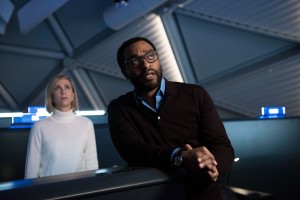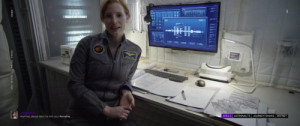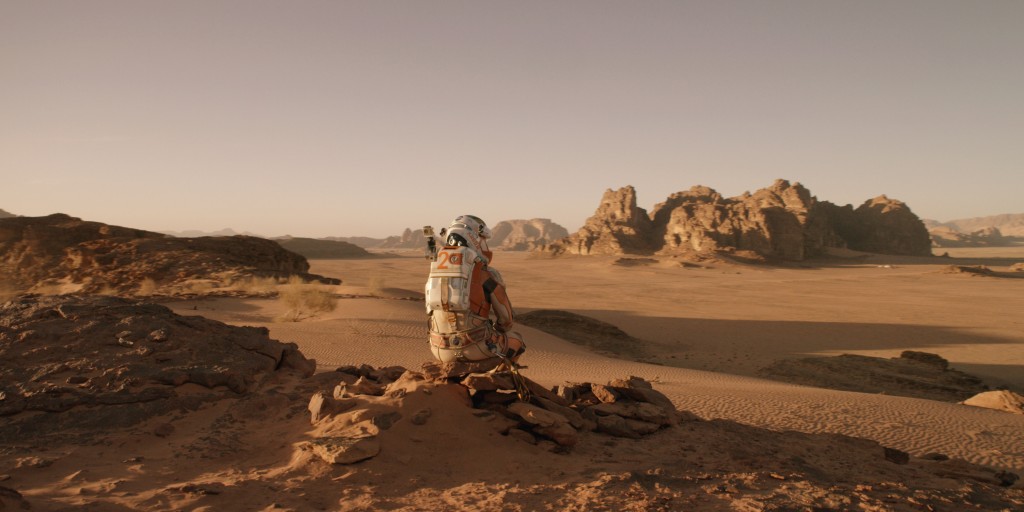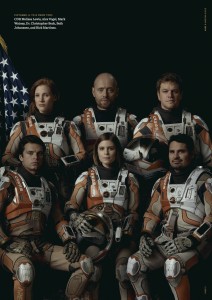Andrew Rostan was a film student before he realized that making comics was his horrible destiny, and he’s never shaken his love of cinema. Every two weeks, he’ll opine on current pictures or important movies from the past.
Last month, Travis wrote about staying up until four in the morning to finish Andy Weir’s novel The Martian in what could only be described as an endorsement for a compelling story. This month, 20th Century-Fox released their blockbuster film adaptation of Weir’s self-published debut, and the result is something more than compelling. The Martian is a triumph for not only science fiction cinema but cinema in general. It is a movie in which every part works, adding up to an extraordinary whole.
For the purposes of this column, I don’t need to probe the plot (Astronaut Mark Watney is stranded on Mars and, with NASA, makes a plan to get home…what else do you need to know?) and will only briefly touch on the themes, which are most eloquently described by Devin Faraci in his review which I urge you to read. Suffice to say that The Martian made me tremble with joy as a film about the very best of humanity: if 2001: A Space Odyssey, my favorite sci-fi film of all time, uses space as a metaphor for the remarkable potential of human beings, The Martian is its natural sequel in its inspirational depiction of how humans use that potential in our gifts of intelligence, creativity, and problem solving. It would not have had such an effect had it not been so outstandingly made. Therefore, in something close to Watney’s philosophy, I’m going to concentrate on The Martian’s components and how they work together.
A Feast of Sight and Sound (aka the Potatoes)
To begin with, The Martian is directed by Sir Ridley Scott, and with it he redeems himself after a decade of mediocrity and the unspeakably terrible Prometheus. Scott is 77, and in this film he brings forth an entire life’s worth of wisdom and instincts for commercial cinema to marshal the production forces at his command. One of Scott’s great strengths is not following the kinetic thrill ride stylings of Alfonso Cuaron or the ponderous ambitions of Christopher Nolan. His sci-fi epic, evocatively shot by Dariusz Wolski and featuring the elegantly simple production design of longtime collaborator Arthur Max, is delightfully classical. The vistas of Mars, the quiet journey of the Hermes spacefraft, and the electric futurism of NASA headquarters recall Kubrick, John Ford westerns, and even Terence Malick’s splendor.
The visuals are underscored by Harry Gregson-Williams’s music, which runs the gamut from simple piano to bursts of strings that would have fit right in with John Barry’s lovelier compositions (and this is one of the highest compliments I can give). There is also a very particular use of pop music in the film which at first left me scratching my head but made so much sense by the final reel: when we are attempting to do that which is hard-verging-on-impossible, we may imagine epic Wagnerian thunder as our theme music, but in reality the soundtrack of our lives we’d most prefer would be something that evokes sentiments of home, love, and family, no matter how potentially cheesy.
 Moving through these sets is one of the most perfect ensemble casts to be assembled in my lifetime, led by a never-better Matt Damon as Watney. Damon, the age of a soon-to-be elder statesman creeping in around the boyish charm, is stoic but ready to laugh, a man who flirts with despair but never gives in to it: there are too many problems to be solved! The finest balance Damon strikes, though, is between Watney’s determination to survive on Mars and pride in his success, and the moments he lets this satisfaction fade into longings to return to Earth and hope that this goal will be reached, whether these moments come in meditation, cutting up his homegrown potatoes, or the way he leaves behind documents for future travelers and signs them “Watney,” a declaration of his name that cements his humanity.
Moving through these sets is one of the most perfect ensemble casts to be assembled in my lifetime, led by a never-better Matt Damon as Watney. Damon, the age of a soon-to-be elder statesman creeping in around the boyish charm, is stoic but ready to laugh, a man who flirts with despair but never gives in to it: there are too many problems to be solved! The finest balance Damon strikes, though, is between Watney’s determination to survive on Mars and pride in his success, and the moments he lets this satisfaction fade into longings to return to Earth and hope that this goal will be reached, whether these moments come in meditation, cutting up his homegrown potatoes, or the way he leaves behind documents for future travelers and signs them “Watney,” a declaration of his name that cements his humanity.
 Damon dominates the proceedings, but the supporting cast all leaves their mark, especially Chiwetel Ejiofor in his first giant role post 12 Years a Slave as Vincent Kapoor, the NASA chief advisor leading the charge to get Watney home. Unruffled but with his words carrying a devoted passion to space and survival and with a twinkle in the eye missing from his Solomon Northrup, Ejiofor spends the film walking the line between practicality and aspiration with the same determination as Damon to succeed; while those two poles are defined by Jeff Daniels as the stern head of NASA and Sean Bean as the roguish crew supervisor, both utter delights. The rest of the cast, boasting everyone from Kristen Wiig to Donald Glover, is similarly terrific…
Damon dominates the proceedings, but the supporting cast all leaves their mark, especially Chiwetel Ejiofor in his first giant role post 12 Years a Slave as Vincent Kapoor, the NASA chief advisor leading the charge to get Watney home. Unruffled but with his words carrying a devoted passion to space and survival and with a twinkle in the eye missing from his Solomon Northrup, Ejiofor spends the film walking the line between practicality and aspiration with the same determination as Damon to succeed; while those two poles are defined by Jeff Daniels as the stern head of NASA and Sean Bean as the roguish crew supervisor, both utter delights. The rest of the cast, boasting everyone from Kristen Wiig to Donald Glover, is similarly terrific…
 But the lion’s share of praise is reserved for Jessica Chastain. Chastain’s Melissa Lewis is in some ways her Zero Dark Thirty heroine in command of a spaceship, with the same single-minded focus, drive, and unwillingness to fail no matter the cost, but the enigmatic qualities of her character that film are here replaced by a warmth, vulnerability, and deep feeling of love. Chastain basically hits all the same marks as Damon with much less screen time, and by the film’s end the audience roots for her as much as Watney. (It helps that the crew of the Hermes—the always welcome Michael Pena, Kate Mara, Sebastian Stan, and Aksel Hennie—all perfectly complement Chastain and each other, especially in a quietly intense kitchen table scene.) This may be a bold call now with so much left in the season, but if Chastain does not receive a Best Supporting Actress award for her performance, it will be a crime against the Oscar gods…
But the lion’s share of praise is reserved for Jessica Chastain. Chastain’s Melissa Lewis is in some ways her Zero Dark Thirty heroine in command of a spaceship, with the same single-minded focus, drive, and unwillingness to fail no matter the cost, but the enigmatic qualities of her character that film are here replaced by a warmth, vulnerability, and deep feeling of love. Chastain basically hits all the same marks as Damon with much less screen time, and by the film’s end the audience roots for her as much as Watney. (It helps that the crew of the Hermes—the always welcome Michael Pena, Kate Mara, Sebastian Stan, and Aksel Hennie—all perfectly complement Chastain and each other, especially in a quietly intense kitchen table scene.) This may be a bold call now with so much left in the season, but if Chastain does not receive a Best Supporting Actress award for her performance, it will be a crime against the Oscar gods…
The Screenplay (aka the Shit)
However, the greater affront in this case would be the failure to recognize Drew Goddard’s screenplay. His adaptation of Weir’s novel is the foundation for the film and it is a work of art all in itself; before the movie ended, the writer in me was recognizing the beauty and magnitude alike of Goddard’s accomplishment.
It would take an even longer essay for me to fully describe what makes The Martian a magnificent screenplay, but here a few points that stood out:
-Goddard integrates the exposition (of which there is barely any) and the hard science of the story into the plot and dialogue with ease. He uses Watney’s video log—a must for a scientific space exploration—to talk through some of the more difficult concepts and creates exciting and fun circumstances for others. The climax of the film features lots of mathematical and scientific dialogue and action set to ABBA (yes, it makes sense) and a daring explosion (yes, this makes sense as well), while one of the most important plot points is explained in a boardroom conference scene that ranks as one of the greatest boardroom conference scenes in the history of film, so much so that certain members of the cast clearly couldn’t keep a straight face.
-Every great screenplay revolves around the same construction that goes into a fine-tuned watch, and Goddard’s script, undoubtedly owing a great deal to Weir’s novel, is a masterpiece of construction. The rises and falls of the action are superbly paced, with a second act full of potential setbacks and a third act with a long, sweeping meditative sequence before a spellbinding finale. Goddard also knows when to introduce information that will come into play for important scenes—presenting it early on to get the audience thinking, but not so early that the audience forgets. (My favorite example is the pacing of when Kapoor and NASA find out Watney is alive, when the Hermes crew finds out, and when they decide what part they will play in the mission.)
-Finally, The Martian has a giant cast crammed into its 140-minute running time, but by the time the film is over the audience feels it genuinely knows all these people, from Benedict Wong’s jovial jet propulsion engineer to Mackenzie Davis as Ejiofor’s eager young right-hand woman. This happens because Goddard is a master, maybe the finest working in Hollywood today, of creating single lines, scenes that last only a few seconds, or tiny running plot threads which reveal so much about a character and put us deep into their heart and soul, opening up a side we may not have expected. Damon gets the lion’s share of this treatment, of course, especially in a scene before he commences his longest and greatest journey, but there are other moments that endure for me as much as the visual spectacular. A ten-second conversation between Chastain and someone on Earth is enough to make you completely fall in love with her character (ditto Pena and Hennie). Daniels comes across as a hard-nosed authoritarian you almost want to root against, but one line of his in the aforementioned boardroom scene reveals the softness and wit beneath his exterior. And there is one particular bit of writing of Goddard’s that really stuck out for me: a throwaway line by Watney about finding old-school adventure games in the base on Mars popped back into my mind when I witnessed a silent exchange between two characters during a montage set to David Bowie’s “Starman,” which in turn set up a sweetly symbolic part of the film’s ending. If you watch the film yourself, keep an eye for this, and how other seemingly “color-providing” lines tie into the plot.
In Conclusion…
The Martian is already set to be a blockbuster. It is also a movie that will hold up on repeated viewings: I can already see it as a film which works perfectly as a serious watch and as something to have on in the background of lazy working days at home, with certain scenes catching your eye—different scenes every time because they’re all great. Above all, The Martian is a film that in these tumultuous times offers a shining, realistic, plausible vision of our world at its best. It already is one of the best movies of my lifetime, and one I simply cannot recommend highly enough.
Photographs from Comic Book Resources, Kumoodi, Ace Showbiz, The Martian tumblr, and PBS.






